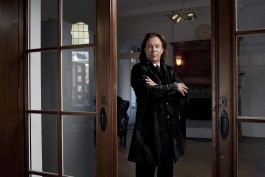



An interview with Dutch architect Erick van Egeraat on changing lifestyles in Moscow and challenges in the Middle East.
Mr. van Egeraat, you have taken over and completed the design of the highest tower in Europe, located in Moscow. On the ground floor you are currently finishing the interior design of the so called World Fashion Club. What can we expect here, what is the guiding idea behind the design?
World Fashion Channel is planning a chain of metropolitan places where visitors can meet, work, relax and get acquainted with the latest fashion trends. The venue in the Mercury City Tower will be the first: a highly flexible space allowing fashion & TV shows, presentations, and café & restaurant use. This flexibility should not be taken for neutral design: a flat floor theatre houses the café / fashion event area finished with concrete flooring, an LED wall and a ceiling with stage lighting, atmospheric lighting and cameras. A raised platform with circular seating hosts a secluded sushi restaurant. Here materials include soft leather seats and the abundant use of Japanese wooden ceiling with soft light effects. The ground floor club will boast large outdoor terraces. The club links the Mercury City tower to its surroundings in an area that is in urgent need for much more activity, on all times of the day.



Russia has been a focus of your architectural work for many years. How has the lifestyle changed in this region over the last years?
I work in many countries, but Russia is, more than any country I work in, a place where multiple realities exist side by side. In Moscow, lifestyle and trends are constantly in flux, and trends alternate on a higher pace than elsewhere. Perhaps a reaction to decades of stagnation, or perhaps because of Russian character: in my experience Russians are maximalists that often embrace their home-grown idea that they base decisions on gut feelings and on instinct much more than on ratio. More than anywhere in Europe, Muscovites are looking for new sensations and impulses to enrich their lives. I find this is a complicated but very interesting context to work in.
What does this imply in the field of city development and architecture?
There is simply a huge need for improvement of everything. Since 2009 I see a very serious shift from excessive capitalist mechanisms aimed at producing volume, to more profound ways of improving quality of life. Out of need, and fear that the city will completely gridlock, Moscow paves the way in improving infrastructure, re-using industrial heritage and revitalizing large parts of its public space. I am closely involved in the transformation of the Red October Factory, just opposite the Kremlin. This has become a beacon for how to develop an industrial building into a hotspot for cultural events, restaurants, clubs, and start-ups. Most of the buildings do not even have monumental status, which until recently in Russia meant that they would have been demolished without hesitation. Now, there is hardly any large urban project in Moscow that does not boast heritage, cultural program and mixed use.
One of your newest projects is the overhaul and extension of a city centre in Saudi Arabia. What are the main criteria within this context to develop a sustainable vision for the future?
Many cities in the Middle East are preparing for a much more competitive future. This poses a huge challenge to good architects. How to bring the client something he truly needs, that can be realized and that no other architect could make possible. The centre of the relatively small City of Unaizah will look and feel like a 21st century but decidedly vernacular city: all parking takes place underground, and above ground streets and squares will be organically lined with contemporary variations on local historical architecture. Trees and urban furniture will offer comfort and shelter from the sun, to ensure a very active public space. In this region cheap and fast construction, glass air-conditioned towers and lack of public space is unfortunately the norm. So it will be quite a challenge to get the support the project needs and to execute it well. But I am certain that this will constitute a sustainable way to develop Unaizahs imago, to attract talented people and investment.



Profil
Erick van Egeraat, born in 1956 in Amsterdam, is founding director of the architecture office (designed by) Erick van Egeraat, which has offices in Rotterdam, Moscow, Budapest and Prague. He graduated from Delft University of Technology in 1984 and was the co-founder of Mecanoo which he left in 1995. Erick van Egeraat’s work, including more than 100 realizations in more than ten countries, received numerous international awards and has been published internationally.
www.erickvanegeraat.com
